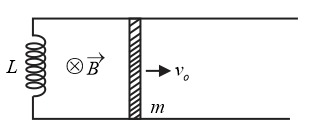Q.
As shown in figure, the two parallel conducting rails, in a horizontal plane, are connected at one end by an inductor of inductance $ \, L$ . A slider (metallic) of mass $m$ , is imparted a velocity $v_{0}$ , upon the rails, as shown in figure. The period of oscillation of the conducting rod is

NTA AbhyasNTA Abhyas 2020
Solution: